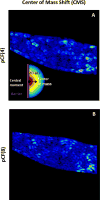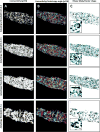Comparison between iMSD and 2D-pCF analysis for molecular motion studies on in vivo cells: The case of the epidermal growth factor receptor
- PMID: 29501424
- PMCID: PMC5999564
- DOI: 10.1016/j.ymeth.2018.01.010
Comparison between iMSD and 2D-pCF analysis for molecular motion studies on in vivo cells: The case of the epidermal growth factor receptor
Abstract
Image correlation analysis has evolved to become a valuable method of analysis of the diffusional motion of molecules in every points of a live cell. Here we compare the iMSD and the 2D-pCF approaches that provide complementary information. The iMSD method provides the law of diffusion and it requires spatial averaging over a small region of the cell. The 2D-pCF does not require spatial averaging and it gives information about obstacles for diffusion at pixel resolution. We show the analysis of the same set of data by the two methods to emphasize that both methods could be needed to have a comprehensive understanding of the molecular diffusional flow in a live cell.
Keywords: Barrier to diffusion; Connectivity maps; Diffusion anisotropy; Fluorescence fluctuation spectroscopy.
Copyright © 2018 Elsevier Inc. All rights reserved.
Figures











Similar articles
-
Quantitative image mean squared displacement (iMSD) analysis of the dynamics of profilin 1 at the membrane of live cells.Methods. 2018 May 1;140-141:119-125. doi: 10.1016/j.ymeth.2017.12.002. Epub 2017 Dec 11. Methods. 2018. PMID: 29242135 Free PMC article.
-
Diffusion Tensor Analysis by Two-Dimensional Pair Correlation of Fluorescence Fluctuations in Cells.Biophys J. 2016 Aug 23;111(4):841-851. doi: 10.1016/j.bpj.2016.07.005. Biophys J. 2016. PMID: 27558727 Free PMC article.
-
Circle scanning STED fluorescence correlation spectroscopy to quantify membrane dynamics and compartmentalization.Methods. 2018 May 1;140-141:188-197. doi: 10.1016/j.ymeth.2017.12.005. Epub 2017 Dec 16. Methods. 2018. PMID: 29258923
-
Imaging molecular interactions in cells by dynamic and static fluorescence anisotropy (rFLIM and emFRET).Biochem Soc Trans. 2003 Oct;31(Pt 5):1020-7. doi: 10.1042/bst0311020. Biochem Soc Trans. 2003. PMID: 14505472 Review.
-
Spatio-temporal image correlation spectroscopy and super-resolution microscopy to quantify molecular dynamics in T cells.Methods. 2018 May 1;140-141:112-118. doi: 10.1016/j.ymeth.2018.01.017. Epub 2018 Feb 2. Methods. 2018. PMID: 29410223 Review.
Cited by
-
Barriers to Diffusion in Cells: Visualization of Membraneless Particles in the Nucleus.Biophysicist (Rockv). 2020 Aug;1(2):9. doi: 10.35459/tbp.2019.000111. Epub 2020 Aug 13. Biophysicist (Rockv). 2020. PMID: 35415463 Free PMC article.
-
The Heterogeneous Diffusion of Polystyrene Nanoparticles and the Effect on the Expression of Quorum-Sensing Genes and EPS Production as a Function of Particle Charge and Biofilm Age.Environ Sci Nano. 2023 Sep 1;10(9):2551-2565. doi: 10.1039/d3en00219e. Epub 2023 Aug 18. Environ Sci Nano. 2023. PMID: 37868332 Free PMC article.
-
Fluorescence Fluctuation Spectroscopy enables quantification of potassium channel subunit dynamics and stoichiometry.Sci Rep. 2021 May 21;11(1):10719. doi: 10.1038/s41598-021-90002-2. Sci Rep. 2021. PMID: 34021177 Free PMC article.
-
Comprehensive correlation analysis for super-resolution dynamic fingerprinting of cellular compartments using the Zeiss Airyscan detector.Nat Commun. 2018 Nov 30;9(1):5120. doi: 10.1038/s41467-018-07513-2. Nat Commun. 2018. PMID: 30504919 Free PMC article.
References
Publication types
MeSH terms
Substances
Grants and funding
LinkOut - more resources
Full Text Sources
Other Literature Sources
Research Materials
Miscellaneous

